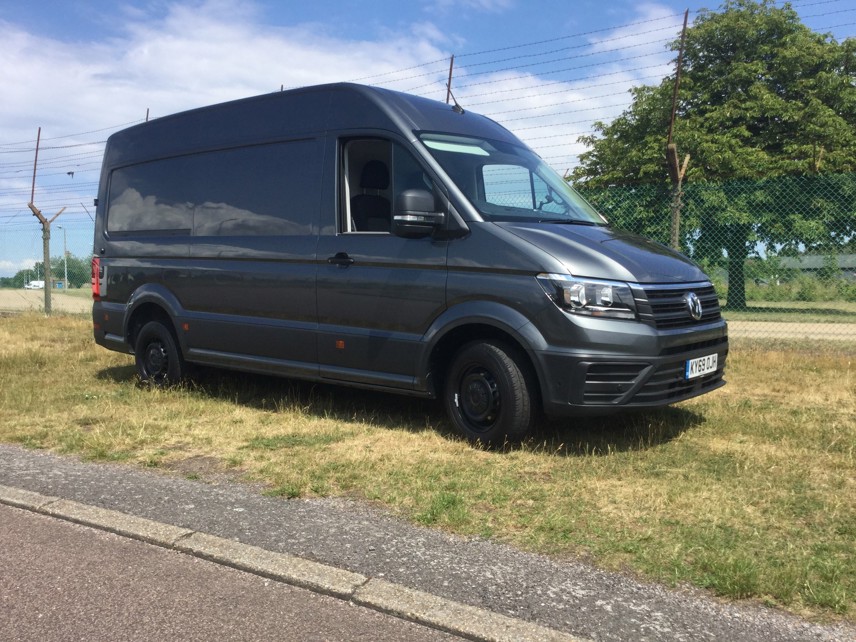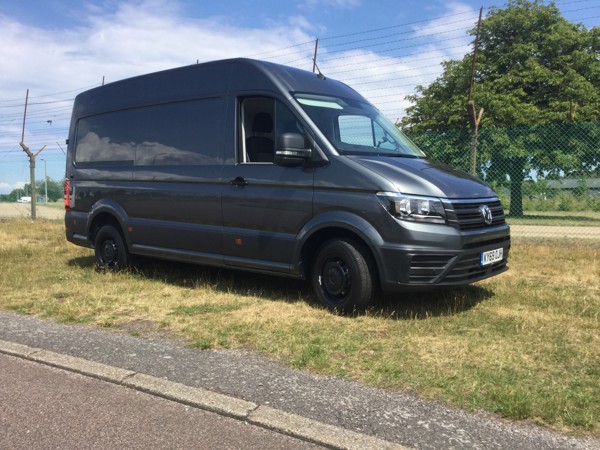Review
Number two daughter was moving house recently which meant I had one of those now-familiar phone conversations that start: ”Dad, you’ve got a big van on test haven’t you…?” By now I know exactly where this is leading!
The upshot was that doting dad was called upon to lug a few loads of household stuff hither and thither, which, at least, gave me the chance to assess the business end of our long-term Crafter before it was returned to Volkswagen this month.
With 11 cu m of space available, we were never going to be short of room, that’s for certain. And, as a six-footer, I could even stand up straight in the back, which was a boon. There’s a non-slip load floor to stop untied cargo from whizzing about in the back and, while the van didn’t have side play-lining, that fact did allow me plenty of holes for use with my collection of ratchet ties.
The rear doors fold right back to 270 degrees, which is handy when loading in tight spaces and there’s a step at the back and even two grab handles at the rear for workers to hoist themselves up. A nice touch that.
My only gripe is that the two roof lights don’t give enough illumination on the load area when it’s dark.
As can be seen from the picture, our van was nowhere near full when I took off with the first load. With not even a half load on board I reckon that we were getting pretty close to the maximum payload of 1,404kg and, despite my daughter’s protestations, I declined to take any more on that trip.
And herein lies the big problem for fleet managers with vans like this. Unless your business is carting feathers back and forth (which is highly unlikely), it’s all too easy to overload a vehicle of this size and thus risk the wrath of the DVSA, not to mention the courts.
Our advice is to fit one of those electronic weighing devices – there are several to choose from on the market. Admittedly, they cost a few hundred pounds per van but it’s a price worth paying if the vehicle is to be kept safe and legal.
The cab is an important part of a van. It’s where your drivers spend their working days, so it’s important that you give them all the creature comforts they deserve.
If I had to be on the road all day, I can’t think of a better place to be than behind the wheel of our Volkswagen Crafter.
For starters, the driver’s seat is about the best in the business, with loads of firm support and even two armrests. My passengers all tell me their seats are pretty good too – and that’s important to me as my wife and I do quite a lot of long trips between Essex and Devon – 300 miles each way. We have yet to experience a single back twinge between us on that journey.
There are plenty of cubby holes and cup holders for the detritus that delivery, utility and construction drivers invariably carry around with them and nice big cola bottle bins in each door for the precious fizzy drink bottle. Personally, I can’t stand the wretched stuff.
There are also some nice little touches like a USB port and cigar lighter port on top of the dash so sat-nav wires aren’t left trailing all over the place and the big display in the middle of the dash seems to do just about everything but cook me a steak and chips with all the trimmings. I’m sure there are still lots of things it does that I haven’t even discovered yet!
There’s even a compass next to the speedometer, which has come in handy on several occasions. That’s something I’ve never seen in a van before.
Mind you, care has to be taken at buying time as many of the goodies on my van turn out to be paid-for options – and some of the prices are eye-watering. For example, the overhead storage shelf comes at an extra £174 and even the bulkhead costs £252.
Having said that, VW offers many safety items as standard so we can’t be too critical.
I was disappointed to read that UK road deaths have flatlined since 2012, according to the latest Department for Transport statistics.
Today’s vehicles are loaded with so many more safety systems than they were back then. I can only put it down to sheer careless driving.
Regarding improved safety systems, take our VW Crafter for example. It has so many safety gadgets on board that only the most inattentive drivers could possibly crash it.
There are the usual systems that come as a legal requirement now, such as ABS brakes and ESC traction control, but also a host of other technology too.
Most notable is the city auto braking system that stops the van automatically if it detects an imminent crash at less than 30mph. That’s standard on all Volkswagen vans now.
Plus, admittedly at an extra cost, our van has the park-assist system that gives a whole series of aural and visual warnings if it feels I’m getting too close to something either back, sides or front.
It’s so effective that it gets on my nerves sometimes. I have been a professional motoring journalist for 30 years now so do know how to drive after all!
Any reversing prangs should be avoided by the addition in our test van of a rear-view camera at £285 – well worth the money in my opinion.
As if all that was not enough, the Crafter also has as standard a crosswind assist system which, in the event of a gust of wind from the side, stops the van being blown across the road.
With that lot available to drivers, all I can say is that if a member of your staff crashes this van, they probably should not be working for you!
After a month driving the VW Crafter on a daily basis (I don’t own a car), I’ve had plenty of time to assess its good points. There are a few minor grumbles – with minor being the operative word.
At first, I was slightly concerned about relying on such a big vehicle for everyday use, but it’s a nimble beast for its size and so easy to manoeuvre that my fears proved unfounded.
The only slight annoyance I found is that I have to stop on the far side of the car park at my local supermarket as the Crafter just doesn’t fit in those silly little spaces.
Mind you, its usefulness with 11 cubic metres of cargo space at the rear makes up for any parking problems.
On the downside, I don’t find the look of the Crafter very inspiring and the dash is positively ugly – but like with many quality German products, it’s a matter of function over form and there are certainly no problems with the way it functions.
Put simply, the Crafter is the slickest, smoothest 3.5-tonne van I have driven in 30 years of testing for Fleet News.
And, given looks are about the last thing a van fleet manager considers when choosing new vehicles, I’ll say no more about the aesthetics.
I’ve always said that once you get over three tonnes gvw, you can forget about vehicles having a car-like feel – their driving dynamics are more akin to trucks than cars. But, with this van, I have to eat my words.
The VW design engineers have sprinkled their magic dust on the Crafter and, apart from sitting up higher, the driver could for all the world be at the wheel of an upmarket passenger car. It makes my poor old 10-plate Fiat Ducato camper van feel positively prehistoric in comparison.
The launch of the current Volkswagen Crafter back in 2017 was a massive deal for VW.
Until then, the Crafter had been a clone of the Mercedes-Benz Sprinter and had come off the same production line, albeit with its own set of engines. As such, the Crafter had played second fiddle to the Sprinter for many years – a situation VW was determined to change.
So, with a new factory in Poland, Volkswagen finally presented the world with a van which could not only compete with the mighty Sprinter, but might actually beat it.
This launch had another significance too – VW is now the only major manufacturer to have its own unique range of vans. All the others use tie-ups with other van makers for some part of their offerings.
Mind you, there are plans afoot for VW to join with Ford to develop vans and pick-ups together, so this present state of affairs might not last long.
I was at the original press launch of the Crafter in 2016 and all the journalists there were impressed with what was on offer. Since then, Volkswagen has been busy hoovering up award after award for its efforts, including large panel van of the year at the 2019 Commercial Fleet Awards.
So, when the Volkswagen press office offered us a Crafter for a three-month stint, we did not need to stop and think before saying ‘yes’.
Our Crafter had been due to arrive a month or so earlier, but the coronavirus pandemic somewhat spoiled those plans.
Our test model is the mid-range Trendline variant in medium wheelbase format, which offers a mighty 11cu m of space and a payload of 1,404kg, which should be plenty for most fleet purposes.
Under the bonnet is a 2.0-litre turbodiesel powerplant with 144PS on tap, which means that, while not offering Tarmac-burning performance, this van is never going to be short of oomph, even fully loaded.
We’re looking forward enormously to putting the Crafter through its paces in the following three months and trying, if we can, to stretch it to its limits.





 Diesel
Diesel












